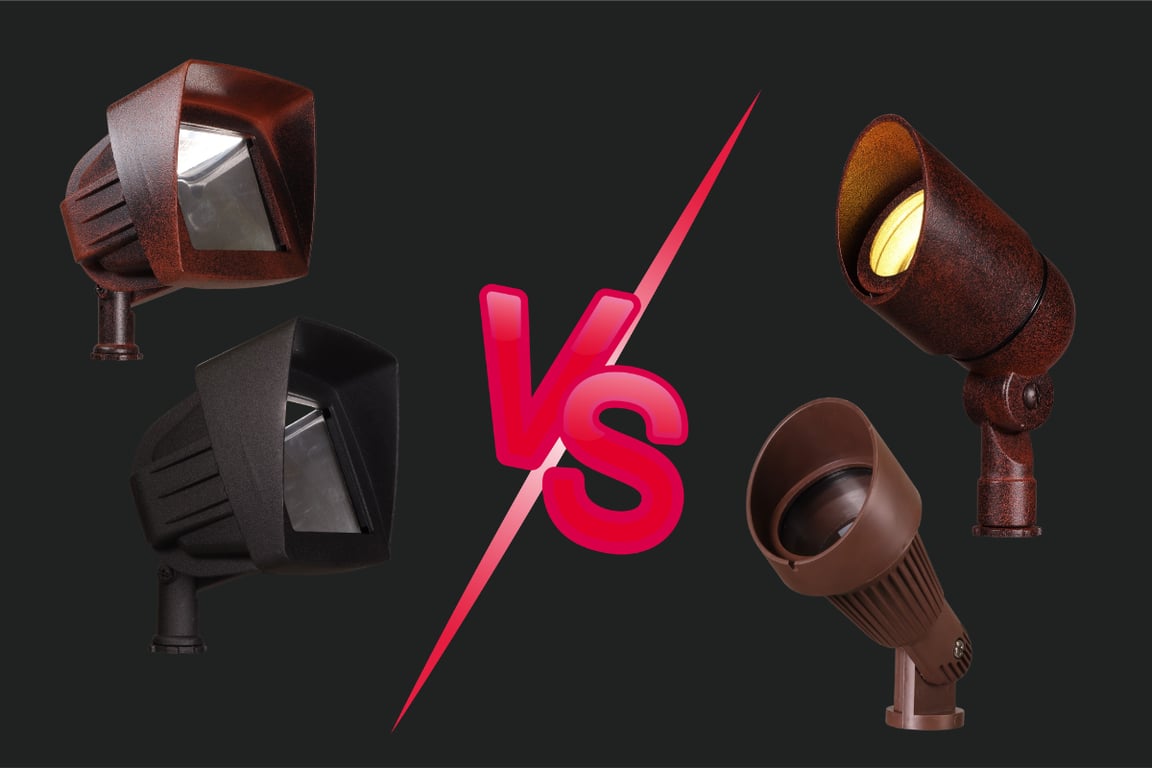Lowest Price Guaranteed Shop Now

When it comes to exterior lighting, the decision between flood lights and spotlights can make a big difference—not only in how your space looks, but also in how it functions. For homeowners, landscapers, and lighting designers working with a trusted supplier like Best Pro Lighting, understanding the difference means you can choose the correct fixture for your needs.
One of the easiest ways to distinguish a flood light from a spotlight is by looking at the beam angle. A beam angle describes the width of the cone of light: how far the light spreads. According to lighting experts, any fixture with a beam angle of around 45° or more is generally considered a flood light, because it illuminates a wide area. On the other hand, a spotlight tends to have a beam angle of around 30° or less, focusing light narrowly on a smaller target.
Because they look similar on the surface (exact bulb sizes, similar fixtures sometimes), the beam pattern often matters most. For example, two similar bulbs might produce dramatically different results depending on whether they’re “flood” or “spot.”
When working with Best Pro Lighting, you’ll have access to various fixtures, beam angles, and finishes—so here’s how to think through the choice.
1. Purpose: Ask yourself, am I lighting a large area or highlighting a feature?
2. Beam angle and throw distance:
3. Fixture style and mounting: Best Pro Lighting offers fixtures optimized for each. A flood is likely if you mount a fixture low and want a broad wash of light. A spotlight is more appropriate if you mount it higher or want to pick out a detail.
4. Aesthetic/desire: Do you want dramatic contrast (spotlight) or a wash (flood)? The right design often uses both: flood lights for general area coverage and spotlights for accents.
5. Energy and glare control: One thing to keep in mind is that a far-reaching beam may cause unwanted glare or light spillage if not aimed properly. Using Best Pro Lighting’s high-quality fixtures with good shielding or precise aiming helps mitigate this.
For example, if you want to light up the entire front yard so you can see everything, choose a flood fixture from Best Pro Lighting. If you make a large tree or a decorative wall the focal point at night, choose a spotlight so the beam is tight and directed.
The best outdoor lighting schemes often combine flood lights to provide the baseline wash of light and spotlights to provide accent and depth. Best Pro Lighting’s catalogue is designed with that mindset. By layering lighting, you avoid everything being flat and equally bright—instead, you create depth, shadow, and visual drama. Design tip: Use flood lighting where you need general visibility and safety, and then follow with spotlights to draw attention and create interest.
While you could buy generic fixtures, choosing a reputable supplier like Best Pro Lighting matters. High-quality goods provide better beam control, longer lifespan, better weather resistance, and reduced maintenance. Invest in outdoor lighting that will operate night after night in diverse conditions, and go with fixtures built to last. Best Pro Lighting offers fixtures specified for exterior performance, with options for beam angles, finishes, and light output—enabling you to choose the right flood vs. spotlight for your application.
Deciding between flood lights and spotlights doesn’t have to be perplexing: focus on what you’re lighting, how far and how wide you want the light to go, and what mood you want to create. Then, with a dedicated partner like Best Pro Lighting providing the right fixtures, you're set. Use a floodlight if you’re lighting a large surface or need wide coverage. If you’re accenting something specific, use a spotlight. Use both where appropriate for light layers and create a rich nighttime environment.
Q: Can I use a spotlight fixture and aim it wide to act like a flood light?
A: You can aim many fixtures wide, but the beam angle is built into the lens/reflector. A fixture designed as a spotlight has a narrow beam and will not spread as broadly without losing intensity. For extensive coverage, a flood-rated fixture is more effective.
Q: Does beam angle automatically tell me the difference between flood and spot?
A: Yes, a good rule of thumb: ~45° or more is a flood; ~30° or less is a spotlight. This is the same principle used by lighting professionals.
Q: Which is better for security lighting?
A: Generally, flood lights are better for security because they cover larger areas and reduce dark zones. However, spotlights can also support security when illuminating specific vulnerable regions.
Q: Can I mix flood and spot lights in the same outdoor scheme?
A: Absolutely; in fact, that’s often the best approach. Floods provide ambient coverage; spots provide focus and depth. Using both gives visual interest and functional lighting.
Q: Does the color temperature or light output change whether a fixture is flood or spot?
A: The beam angle (flood vs. spot) refers to the spread of light, not the color temperature or lumen output. You can get flood and spot fixtures in the same color temps and brightness levels, so choose these based on your design and function requirements.
Q: What about energy efficiency and maintenance?
A: Whether you choose flood or spot, opt for high-quality LED fixtures (such as those from Best Pro Lighting). LED lighting offers a longer lifespan, lower energy use, and less maintenance than older halogen or incandescent options.
Q: How high should I install each type for the best effect?
A: There's no one-size-fits-all solution, but generally, for flood lights aiming at a broad area, lower mounting (e.g., under eaves) works well. For spotlights highlighting a feature, mounting higher up and pointing downwards can give dramatic results. Constantly adjust aim and positioning during installation for the best coverage with minimal glare.